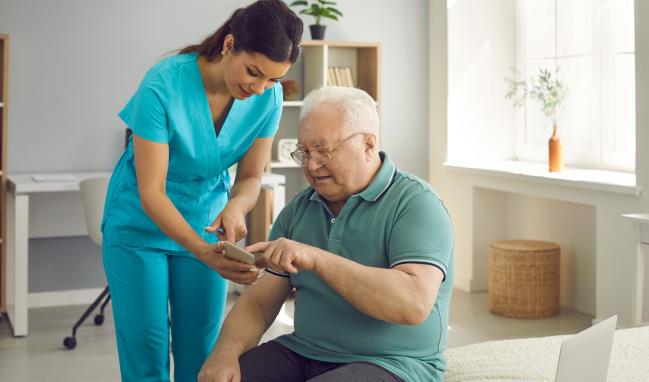Remote Monitoring in Real-world HF Cuts All-Cause Mortality: TELESAT-HF
These data are observational but suggest that basic remote monitoring of weight and symptoms can cut patient risk.

LISBON, Portugal—Use of algorithm-based remote patient monitoring significantly cut the risk of all-cause mortality in patients with heart failure (HF) when compared with the current standard of care, according to results from the TELESAT-HF study.
Nicolas Girerd, MD, PhD (Centre Hospitalier Régional Universitaire de Nancy, France), who presented the real-world data at the European Society of Cardiology’s Heart Failure 2024 Congress, reported that simply tracking body weight and symptoms on a weekly basis reduced the risk of all-cause mortality by 36% over 30 months.
The remote monitoring system (Satelia; Cardio), which relies on a series of regularly asked questions, is “not rocket science,” Girerd told TCTMD. Monitoring consists of “very basic stuff, but sometimes doing the basic stuff is important,” he said.
As for what aspect of care remote monitoring is affecting to cut the risk of mortality, Girerd said it’s not possible to point to any single factor.
“I think it's many things,” he said. “You have the education [component], this has an impact. You also have alerts where you might act with diuretics for a few days to decrease congestion and try to prevent the hospitalization. Also, you have a link with the patients and the chances are you will increase the use of [guideline-directed medical therapy] more than if you didn’t have this [connection].”
Remote monitoring also establishes a network of care, with the HF nurse and cardiologist, among others, having access to the patient’s weekly data, which would likely influence how they are managed. “It's an aspect where several people have the information,” he said. “I think that this dynamic is important, too.”
Digital Skills Not Necessary
The remote monitoring system, which has CE Mark approval, doesn’t require software installation, applications, or external sensors and is intended for patients with a range of digital literacy, including those with no knack for modern technology.
The platform requires patients to answer questions each week about their weight and symptoms: for example, do you feel out of breath at rest? Are your ankles swollen this morning? Do you feel more out of breath when making an effort compared with last week? The answers can be provided via the internet or on a phone call with a nurse for those with no or poor digital literacy.
Based on the answers, a score of 0-36 points is calculated, with higher scores triggering alerts to the healthcare team. Practitioners analyze the data and reach out to patients as needed, said Girerd. It gained traction in France following the Ministry of Health’s recent decision to provide funding for remote patient monitoring of noncommunicable diseases, among them congestive heart failure.
“The use increased a lot during COVID, because it was a good way to manage people outside of the hospital and, luckily, we discovered that it worked reasonably well,” Girerd told TCTMD. “It does seem to be something that will stay. They also increased the reimbursement because this is a lot of work. You have to act on the alerts.”
The TELESAT-HF study included patients with NYHA functional class II or higher and elevated brain natriuretic peptide (BNP) or NT-proBNP levels or those hospitalized within the past 12 months for HF decompensation between 2018 and 2022. In total, 5,357 patients were cared for with remote monitoring and these were propensity matched with 13,525 patients treated with usual care. More than 55% of patients had a history of coronary heart disease, more than 85% had hypertension, and approximately one-third had diabetes mellitus.
The reduction in all-cause mortality (HR 0.64; 95% CI 0.59-0.70) was seen consistently in male and female patients as well as in young and old patients. Interestingly, investigators observed an interaction by means of follow-up. Those with limited digital literacy who reported their weight and symptoms via phone had a 46% lower risk of all-cause mortality compared with usual care whereas those monitored with the web-based platform had a 33% lower risk of death (P = 0.006 for interaction).
“That result was not really expected,” said Girerd. “The patients who were digitally illiterate seem to have a more sizeable reduction in events.”
Maria Rosa Costanzo, MD (Midwest Cardiovascular Institute, Naperville, IL), the discussant following the late-breaking clinical trial presentation, questioned whether this observed interaction might be attributable to something else entirely. “It makes you think whether the human touch of a nurse calling was responsible for the better results and nothing to do with digital literacy,” she said.
The observed benefit with remote monitoring couldn’t come at a more opportune time given the reversals in HF outcomes seen elsewhere, said Costanzo. “We have recently seen the reversal of the decline in heart failure mortality in the US,” she said. “We have lost all the advantages that we had acquired up to 2012.”
Human Aspect May Be Important
Some of the earliest randomized trials testing a simplified approach relying on the transmission of body weight, vital signs, and/or symptoms didn’t translate into a clinical benefit in HF patients, but these trials led to more sophisticated forms of remote monitoring that have been more positive.
Implantable pulmonary artery pressure (PAP) monitoring, for example, has been shown to successfully reduce HF hospitalizations and improve quality of life, as well as all-cause mortality in some studies, across a range of patients with HF. In Europe, the 2021 HF guidelines awarded invasive PAP monitoring a IIb recommendation in symptomatic HF patients with LVEF < 35%. Noninvasive home telemonitoring is also a IIb recommendation to reduce the risk of recurrent cardiovascular events, including cardiovascular mortality, and HF hospitalizations for HF patients.
Costanzo noted that in the CHAMPION trial with CardioMEMS (Abbott), they had strict criteria on when to intervene and what defined a resolved/unresolved HF event. In that trial, there were more medication changes in those who were monitored, which translated into lower pulmonary artery diastolic pressures, and this led to fewer hospitalizations.
“In TELESAT, the task is much harder because you didn’t have these precise targets [for intervention],” she said.
To TCTMD, Girerd acknowledged the study is observational and subject to the usual limitations. He added that only a randomized, controlled trial will be able to tease out the true benefits of this minimalist approach to remote monitoring. That said, he believes the technology is scalable and should be easy to implement provided reimbursement is available, which it isn’t in all countries.
Michael O’Riordan is the Managing Editor for TCTMD. He completed his undergraduate degrees at Queen’s University in Kingston, ON, and…
Read Full BioSources
Girerd N, on behalf of the TELESAT investigators. Impact of a remote monitoring program on all-cause mortality of patients with heart failure: National, real-world evidence of the TELESAT study. Presented at: ESC Heart Failure 2024. May 11, 2024. Lisbon, Portugal.
Disclosures
- Girerd reports receiving consulting fees/royalties/shares with AstraZeneca, Bayer, Boehringer Ingelheim, Lilly, Novartis, NovoNordisk, NP Medical, and Echosens.





Comments